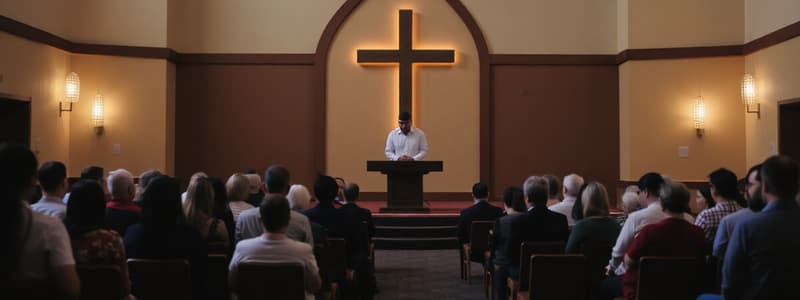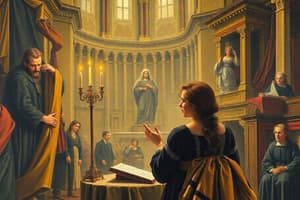Podcast
Questions and Answers
What was the initial assessment of the Marble Collegiate Church's physical condition upon the narrator's arrival?
What was the initial assessment of the Marble Collegiate Church's physical condition upon the narrator's arrival?
- The church was modern and well-equipped for its programs.
- The church was adequately maintained with minor improvements needed.
- The church was outdated and lacking in suitable facilities for a modern program. (correct)
- The church was a beautiful, fully renovated historical landmark.
What was the narrator's primary concern regarding the church's congregation size?
What was the narrator's primary concern regarding the church's congregation size?
- The church required sensational preaching to attract more attendees.
- The church needed to focus on increasing membership numbers at any cost.
- The church had a large membership but low attendance. (correct)
- The church was already at full capacity every Sunday.
How did the narrator's wife, Ruth, influence his approach to his ministry?
How did the narrator's wife, Ruth, influence his approach to his ministry?
- She advised him to leave the church and find a new ministry.
- She encouraged him to adopt sensational preaching methods.
- She prompted him to seek a deeper spiritual experience and renew his faith. (correct)
- She suggested he focus on improving the church's physical facilities.
What was the turning point for the narrator's outlook on his ministry at the Marble Collegiate Church?
What was the turning point for the narrator's outlook on his ministry at the Marble Collegiate Church?
How did the narrator address the financial challenges faced by the Marble Collegiate Church?
How did the narrator address the financial challenges faced by the Marble Collegiate Church?
What approach did the narrator take to increase the church's visibility and attract new members?
What approach did the narrator take to increase the church's visibility and attract new members?
What was the primary basis of the narrator's ministry in New York?
What was the primary basis of the narrator's ministry in New York?
How did the narrator handle disagreements or opposition from influential members of the church?
How did the narrator handle disagreements or opposition from influential members of the church?
How did the Marble Collegiate Church respond to the attack on Pearl Harbor?
How did the Marble Collegiate Church respond to the attack on Pearl Harbor?
Why did many young American military personnel visit the Marble Collegiate Church during World War II?
Why did many young American military personnel visit the Marble Collegiate Church during World War II?
What underlying issue strained the narrator's relationship with the elder William S. Denison?
What underlying issue strained the narrator's relationship with the elder William S. Denison?
What did the narrator do in response to the news of the Pearl Harbor attack during the Sunday evening service?
What did the narrator do in response to the news of the Pearl Harbor attack during the Sunday evening service?
What action did the church take regarding Reverend Sojiro Shimizu's scheduled speaking engagement after the Pearl Harbor attack?
What action did the church take regarding Reverend Sojiro Shimizu's scheduled speaking engagement after the Pearl Harbor attack?
What significant event occurred in Pawling, New York, on August 9, 1945?
What significant event occurred in Pawling, New York, on August 9, 1945?
What was the narrator's initial strategy for filling the empty seats in the Marble Collegiate Church?
What was the narrator's initial strategy for filling the empty seats in the Marble Collegiate Church?
What did the narrator ultimately decide was more important than filling seats?
What did the narrator ultimately decide was more important than filling seats?
What promise was made to those who learned the biblical admonition of tithing?
What promise was made to those who learned the biblical admonition of tithing?
How did the ministry adapt to the changing demographics during the war?
How did the ministry adapt to the changing demographics during the war?
What action demonstrated Marble Collegiate Church’s commitment to intercultural unity despite the conflict of World War II?
What action demonstrated Marble Collegiate Church’s commitment to intercultural unity despite the conflict of World War II?
Flashcards
The Parlor
The Parlor
A large room behind the sanctuary used as a passageway and for dinners.
Preaching Center
Preaching Center
The church was primarily viewed as a place for sermons, with less focus on comprehensive community programs.
Ruth's Intervention
Ruth's Intervention
The author's wife, Ruth, challenged him to deepen his faith and trust in God.
Spiritual Experience
Spiritual Experience
Signup and view all the flashcards
Preaching Human Need
Preaching Human Need
Signup and view all the flashcards
Ministry Based on Gospel
Ministry Based on Gospel
Signup and view all the flashcards
Tithing
Tithing
Signup and view all the flashcards
Cooperative Leadership
Cooperative Leadership
Signup and view all the flashcards
Service to People
Service to People
Signup and view all the flashcards
Higher power
Higher power
Signup and view all the flashcards
Christian Brotherhood
Christian Brotherhood
Signup and view all the flashcards
Study Notes
- The author began a tough job at a church that was physically limited and had a small, though dedicated, congregation.
- The staff consisted of Rev. Albert A. Leininger and Miss Merce E. Boyer.
- The church had low attendance with about 200 of 500 members attending morning service, slightly more on Sunday nights, and 50-60 at Wednesday prayer meetings.
- The church building was largely unchanged since 1854.
- There was a dirt-floored basement with five-foot headroom, containing several furnaces connected by a brick walk.
- The church was primarily a "preaching center."
- The board and staff were eager to innovate, offering enthusiastic support.
- The author decided to focus on filling souls with the Gospel of the Lord Jesus Christ, preaching to human needs in understandable language.
Vacation in England
- During a vacation in Keswick, England, in the summer of 1933, the author felt restless and depressed about the church's situation.
- Ruth provided therapy, urging him to have faith and trust in God.
- Ruth challenged the author, stating he needed a deep spiritual experience and to get really converted as his current conversion "didn't take."
- Urged by his wife, the author prayed for strength and divine mercy.
- The prayer was answered instantly, bringing joy and a feeling of warmth.
- The author and his wife immediately returned to New York, seeing the church's problem with a new spirit and perspective.
New Approaches
- The author appeared on Ralph Edwards's "This Is Your Life" TV show and described this experience in England.
- The author began accepting invitations to speak at various gatherings, emphasizing personal growth through a Higher Power.
- The church began to fill with people, resulting in overflow congregations for over 40 years.
- To replace the $10,000 donation from Mr. Hyde, the author asked for smaller gifts from many people, more than doubling the previous total.
- The ministry was based on believing the church could only improve (as it was already "way-down"), preaching the Gospel, and using simple language.
Challenges
- The author faced opposition from two elders: one attempted to control his actions and preaching style, and the other, William S. Denison, saw himself as the author's "boss."
- Denison wanted the author to clear his absences for speaking engagements and expected him to be on the job every day.
- Despite the challenges, the author maintained a friendly relationship with Denison, playing golf with him.
- After the departure of both men, the church board operated cooperatively without attempts to control the minister.
Pearl Harbor
- On December 7, 1941, the church was packed for the evening service following the attack on Pearl Harbor.
- The author led the congregation in singing "The Star-Spangled Banner," followed by repeating James A. Garfield's words: "God reigns, and the Government at Washington still lives!".
Demonstrating Brotherhood
- The author insisted that Reverend Sojiro Shimizu, pastor of the Japanese Reformed Church in New York City, still speak at the church despite the Pearl Harbor attack.
- The audience applauded Reverend Shimizu, demonstrating Christian brotherhood.
- The ordination of Toru Matsumoto, a Japanese man, to the Christian ministry proceeded as planned, with police protection.
- Matsumoto later returned to Japan and became a popular radio speaker, influencing his people toward Christianity.
World War II
- During January and February 1942, many young men and women in uniform, passing through New York on their way to the front in Europe, attended the church.
- Church members provided social events and dinners for these service members, offering them affection and a friendly welcome.
- On August 9, 1945, after the announcement of the end of World War II, the church bell on Quaker Hill rang out, summoning people for a service.
- The service included speeches from Governor Thomas E. Dewey, Lowell Thomas, and the author, who emphasized freedom under God.
Studying That Suits You
Use AI to generate personalized quizzes and flashcards to suit your learning preferences.





